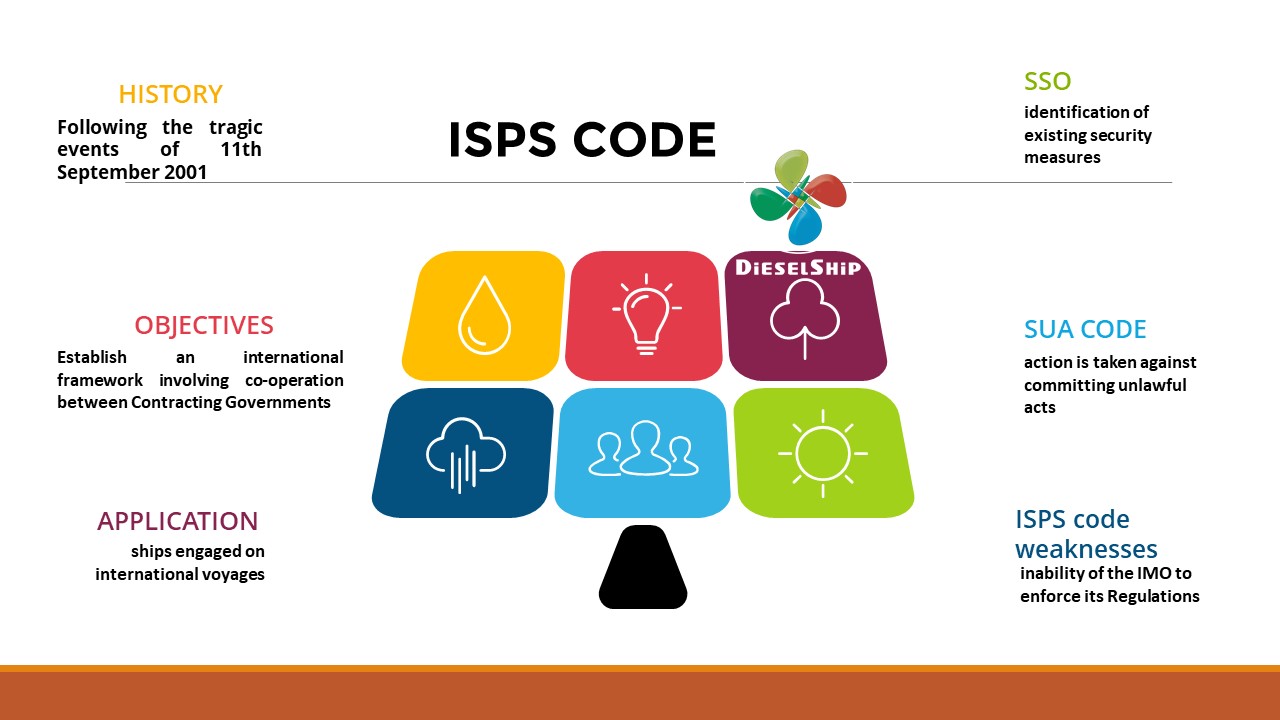ISPS CODE – The International Ship and Port Facility Security Code

ISPS CODE
The International Ship and Port Facility Security (ISPS) Code
- The ISPS Code is implemented through chapter XI-2 Special measures to enhance maritime security in the International Convention for the Safety of Life at Sea (SOLAS).
- The Code has two parts,
- one mandatory and
- one recommendatory.
HISTORY
- Following the tragic events of 11th September 2001, the twenty-second session of the Assembly of the International Maritime Organization (IMO), in November 2001, unanimously agreed to the development of new measures relating to the security of ships and of port facilities for adoption by a Conference of Contracting Governments to the International Convention for the Safety of Life at Sea, 1974 (known as the Diplomatic Conference on Maritime Security) in December 2002. Subsequently the International Ship and Port Facility Security (ISPS) Code is developed for the compliance of the contracting governments. The code is to be globally implemented on 1 July 2004
- Development and implementation were sped up drastically in reaction to the September 11, 2001 attacks and the bombing of the French oil tanker Limburg.
OBJECTIVES OF THE ISPS CODE
- To establish an international framework involving co-operation between Contracting Governments, local administrations and the shipping and port industries to detect security threats and take preventive measures against security incidents affecting ships or port facilities used in international trade;
- To establish the respective roles and responsibilities of the Contracting Governments, Government agencies, local administrations and the shipping and port industries, at the national and international levels for ensuring maritime security;
- To ensure the early and efficient collection and exchange of security-related information
- To ensure the early and efficient collection and exchange of security-related information
- To ensure confidence that adequate and proportionate maritime security measures are in place.
APPLICATION OF THE ISPS CODE
The SOLAS Chapter XI-2 and the ISPS Code apply to the following types of ships engaged on international voyages:
- passenger ships, including high-speed passenger craft
- cargo ships, including high-speed craft, of 500 gross tonnage and upwards
- mobile offshore drilling units
European Commission Regulation 725/2004 extends the scope of compliance to include:
- domestic ‘Class A’ passenger ships (domestic ships which travel more than 20 miles from a place of refuge)
- domestic ships required to comply by an EU member state’s risk assessment – for the UK this covers ships certified to carry more than 250 passengers and tankers
Requirement of SSO
- identification of existing security measures, procedures and operations;
- identification and evaluation of key ship board operations that it is important to protect;
- identification of possible threats to the key ship board operations and the likelihood of their occurrence, in order to establish and prioritise security measures; and
- identification of weaknesses, including human factors in the infrastructure,policies and procedures
SUA and ISPS CODE
- The main purpose of the convention is to ensure that appropriate action is taken against persons committing unlawful acts against ships.
- The International Ship and Port Facility Security Code (ISPS Code) is a comprehensive set of measures to enhance the security of ships and port facilities, developed in response to the perceived threats to ships and port facilities
- SUA Convention is, however, expected to provide the legal basis for the arrest, detention and extradition of terrorists in the event of a terrorist attack against shipping
- The 1985 hijacking of the passenger vessel AchilleLauro off the coast of Egypt led to the 1992 adoption of international law in the form of the Convention for the Suppression of Unlawful Acts against the Safety of Maritime Navigation (SUA Convention).
- Recent terrorist attacks on maritime vessels, including the previously mentioned attacks on the USS Cole and the tanker Limberg, demonstrated the SUA Convention’s inadequacy to proactively address the maritime security threat posed by terrorism.
- To this end, in December 2002, the International Maritime Organisation (IMO) convened a Diplomatic Conference addressing measures to strengthen maritime security and prevent and suppress acts of terrorism against shipping.
- This conference resulted in the adoption of a number of amendments to the SOLAS Convention, including, the addition of a new chapter detailing the new ISPS Code.
- Other SOLAS amendments included the requirement for ships to fit Automatic Identification Systems (AIS), to carry a Continuous Synopsis Record (CSR), and to standardise ship identification markings
ISPS code weaknesses
- One major weakness of the Code is the inability of the IMO to enforce its Regulations—it can only monitor compliance.
- Enforcement is the domain of Contracting Governments, most often as a part of Port State Control regimes.
- some Contracting Governments, particularly Flag of Convenience registries, have been identified as either corrupt (and therefore vulnerable to exploitation by terrorist groups), or as lacking the resources or expertise to enforce acceptable standards.
- The ISPS Code does not apply to many vessels that are either vulnerable to, or capable of, terrorist attack or exploitation. These include fishing vessels, high speed container vessels built prior to July 2001, vessels not engaged in international voyages (including inter-island ferries similar to the ones attacked in recent years in Southeast Asian waters), and cargo ships less than 500 ton. Part B of the ISPS Code advises Contracting Governments to establish security measures for vessels not covered by Part A of the Code, however, this is not mandatory, and is therefore unlikely to be heeded by some nations (particularly Flag of Convenience registries).


